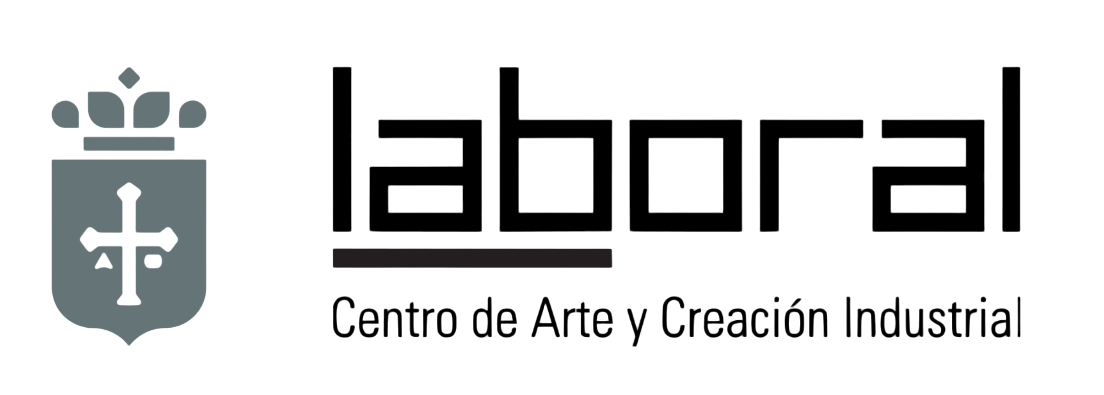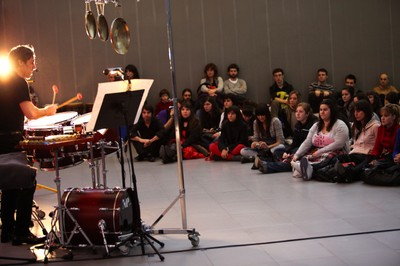The Gijón Contemporary Music Meetings, created and starred by the Ensemble Residencias thanks to the support of the INAEM and the Cristina Masaveu-Peterson Foundation, offer in their first edition a cycle of 7 concerts in which compositions of the most recent creation – among them 2 commissions for the festival and 3 absolute premieres (Juan Cué, María de Alvear and Roberto Sierra) – go hand in hand with masterpieces by already established composers of the 20th century.
The concerts take place in different spaces of the Laboral City of Culture, LABoral Center for Art and Industrial Creation, as well as at the Jovellanos Theater over 3 meetings in October, November and December 2008.
These concerts are accompanied by conferences and round tables about numerous aspects of current creation, with the aim of facilitating access and understanding of this repertoire.
With the performance of the “Quartet for the End of Time”, considered one of the masterpieces in the history of chamber music, the Meetings were inaugurated on October 28, paying tribute to the Centenary of his birth to Olivier Messiaen ( 1908-1992), one of the greatest French composers of all time.
The second meeting is held entirely at the LABoral Center for Art and Industrial Creation on November 11 and 12, 2008. An avant-garde space with minimalist architecture, where two concerts are offered: “Drumming” and “Destellos de la resonance”, with an instrumental template based on the two groups that make up the Ensemble Residencias: Neopercusión and Trío Arbós.
The first concert -Nov. 11-, presents works by two great American composers who are already part of the history of music, John Cage and Steve Reich, along with a very recent work by the Catalan composer Ramón Humet.
John Cage, without a doubt one of the great composers of the avant-garde. Cage’s mark spread and stimulated the exploration of new forms of sensitivity in Western art. Influenced by Varese, Ives, and Zen Buddhism, Cage collapsed the usual limits of musical experience. In the program “loves” and “second construction” two works of percussion and piano where the piano has to be prepared using screws, nuts and rubber elements. Almost Cage’s most striking innovation in the instrumental field: the creation of the “prepared piano.”
Cage’s other work, highly influenced by Zen Buddhism and perhaps his most famous work: “4 minutes and 33 seconds” from 1952. Mythical work from the 19th century. XX, in whose score only the word “TACET” is indicated next to the time of each movement: the performer must only let the time pass. The title refers to the duration of the work and is an attempt to demonstrate that “total silence” does not exist, “silence is only the abandonment of the intention to hear”, being able to hear through the silence the sound that was in that room beforehand, the environmental sounds, the natural sounds of the environment in which the piece of “non-intention” is performed, a kind of space to reflect first, about the fact that silence is only the loss of attention to an event, to find the true nature of the sound in the present.
After this experience, the spectacular Drumming (1970) by Steve Reich, considered “the best American composer still alive,” will play. Work influenced by African polyrhythms where Reich develops the technique known as ‘phase shifting’, where two or more instruments interpret an identical phrase but at different speeds. The first part will be performed for bongos, in a Neopercusión trio version.
It completes the program “zen gardens” by the Catalan composer Ramón Humet (1968), for percussion trio with solo vibraphone that denotes a special sensitivity for the timbral quality of the sound. It was commissioned by Neopercusión and just a few days ago it premiered at the Guggenheim in Bilbao.
The second concert -Nov. 12- titled “Destellos de la Resonancia” is made up of two duets with percussion from 2000 and two trios from 2008, commissioned by the Arbós Trio and sponsored by the Siemens Foundation. Opens the program Ficciones (violin and percussion ) by the Valencian composer Miguel Gálvez, inspired by the readings of Borges and Octavio Paz, with great melodic and expressive lines. It is worth highlighting an absolute premiere: Trío III (“Romantic”) by the Puerto Rican composer living in the United States Roberto Sierra, a favorite student of Ligeti in which it is worth highlighting his harmonic-melodic language full of gestures and rhythms of Afro-Caribbean inspiration, rhythms that Ligeti also incorporated in some of his works thanks to the influence of Sierra. From Sierra we will also hear the duo that gives its name to the program, Destellos de la Resonancia for piano and percussion.
The other Trio 3 in the program is by José Manuel López López, recently premiered in the Residencias cycle within the CDMC concert season at Auditorium 400 of the Reina Sofía Museum in Madrid. López’s work explores the granular treatment of sound matter and temporal modulations, which generate independent layers of times that overlap and cohabit, where it is worth highlighting the virtuosity of the piano and the manipulation of the timbre of the strings inside the instrument. by one of the components of the trio, which allows two, three or more instruments to be obtained inside one of them by turning off or letting the strings resonate.
The concert will be preceded by a talk – conference with the composers Roberto Sierra and José Manuel López López, who will present their works and talk about the connections between America and Spain in current composition.
In parallel, an International Contemporary Music CLASSROOM (AIMC) is offered at the Superior Conservatory of Music of Oviedo with various instrumental and composition specialization workshops, taught by members of the Ensemble and guest artists.
During the second Meeting (November 11 to 13), two instrumental workshops are offered, a Chamber Music Course (11.11) taught by the pianist of the Trío Arbós, Juan Carlos Garvayo, oriented to the contemporary repertoire mainly of the piano trio formation . And a Percussion Workshop (12.11) with Juanjo Guillém in which the reference works will be Drumming for bongos by Steve Reich and the new work “Zen Gardens” by Humet, highlighting his meticulous work with resonance in the metals and in particular the technique of the vibraphone. The Composition Master Classes will be led by the composers Roberto Sierra (12.11) and José Manuel López López (11.13). Each one will make an introduction to their artistic thinking and approach to their compositional technique/s, as well as in the case of Sierra they will discuss “the influence of Afro-Cuban rhythms in their music” and in the case of José Manuel López, as a tribute On the tenth anniversary of the death of Gérard Grisey (1946-1998), he will talk about “the French spectral school.”
It is an honor to have the Ensemble Residencias in Gijón, both its musician members of unquestionable commitment and rigor, as well as the collaborators and guest artists, will delight everyone who has the possibility of coming to Gijón to enjoy any of the meetings. He is the main person responsible for making a project of these characteristics viable in Spain and especially through these Meetings in Asturias.
Isabel RequeijoArtistic CoordinatorContemporary Music Meetings
Program
Tuesday, November 11, 2008, at 8 p.m.
John Cage (1912 – 1992): Second construction (1940)
Ramón Humet (1968): Four Zen Gardens (2008)
John Cage (1912 – 1992): Loves (1943)
Steve Reich (1936): Drumming (1970)
Flashes of resonance
Wednesday, November 12, 2008, at 8 p.m.
Miguel Gálvez (1974): Fictions (2000)
Roberto Sierra (1953): Trio 3* (2008)
Roberto Sierra (1953): Flashes of resonance (2000)
José Manuel López López (1956): Trio III** (2008)
*Full premiere, sponsorship by the Ernst von Siemens Foundation**Sponsorship by the Ernst von Siemens Musikstiftung

